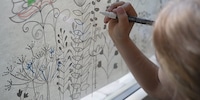

Terrible at drawing? Nonsense! This book will show you how it’s done
From rough sketches to smaller concept visualisations: Sketchnote Journal will help you along the way with helpful tricks and simple exercises. Time to hit those pens – no excuses!
There’s always that one child in art class at school. The one who’ll be staring at a blank piece of paper, arms crossed witha frown, making it very clear to the teacher: I can’t and won’t draw.
If you can relate to that kid, this is your chance. No need to run and hide, quite the opposite, in fact. Trust me, it’s a sign. Go and fetch that dusty sketchbook and check if your felt-tip pens are still working.
Not just for beginners or the inartistic
The book is aimed at shy drawing novices and anyone wanting to emphasise written content with easy-to-understand, personal drawings.
Lesson 1: the visual ABC
«The aim isn’t to create a work of art,» say authors Sabine Wein and Anna Frank early on in the book, thereby managing expectations. The only thing that matters is that you start drawing. It’s like learning a new language. Your key to success is practise and getting the basics right. The book builds on the visual ABC, which breaks down drawings and symbols into their basic shapes – circles, triangles and squares.
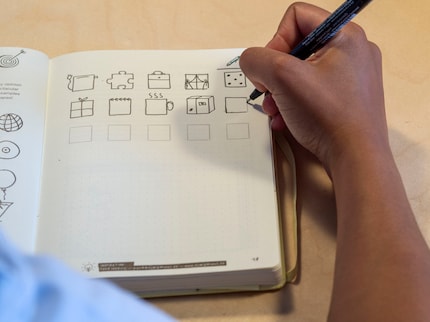
Finger warm-up
After the introduction, the book continues with warm-up exercises. Manic scribbling and repetitive shapes get me in the flow and limber up my rusty fingers. The exercises should also help me shake my tendency for perfectionism. It works well, I guess I should do it more often.
Practising ad nauseam
Once my fingers have got into the groove, the journal introduces me to the basics of symbols. Broken down into individual grey parts, I learn how to build the icons step by step until they’re complete. Just like how I learned to write.
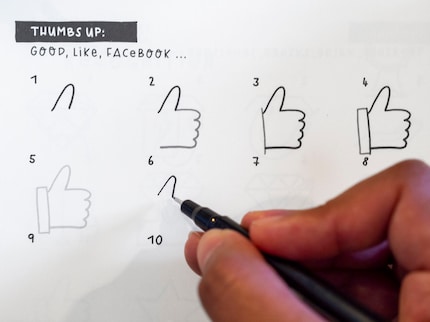
Sadly, there’s a catch. Because of the cardboard cover, the journal doesn’t lie flat on the table when you’re working, meaning your drawing surface is slanted. This makes it hard to do the exercises properly, because I either have to press the book firmly onto the table or draw at an uncomfortable angle. What saved me was this pro tip from my co-worker Michelle Brändle , who suggested placing another book underneath it. Sure enough, that did the trick.
Spanning almost fifty pages, there are exercises on various symbols. The aim? To put together a collection of icons that’ll come in handy in everyday life. The journal recommends you create an «icon library» to fall back on.

After just a few repetitions, drawing the icons becomes easier. But what it’s really about is understanding the drawing style and then finding your own. So I put the template aside, look around my chaotic desk and let a few objects inspire me. And lo and behold, the key isn’t to draw them as realistically or three-dimensional as possible, but to trace them back to the basic shapes featured in the visual ABC.
A few pages in, it’s time to transform everyday objects into symbols. Oops, looks like I got one step ahead of the book.
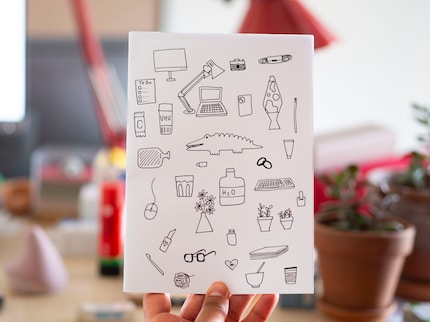
Emotional people and objects
The part I found the most fascinating was the bit that tells you how to draw emotions to make your sketches come to life. Once you’ve got that down, two eyes and a mouth will turn a drawing of our planet into a weeping earth. And if you add four strokes for arms and legs, you’ll have that same earth jumping for joy or crossing her arms in anger.
The same chapter covers how to breathe so much life into stick figures they’ll resemble real people. This inspires me to draw the wonderful team I work with.
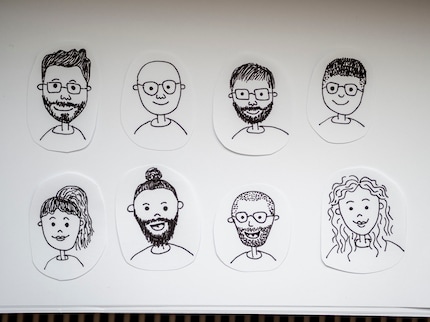
Letters and layout
To really set the scene for your illustrations, the book concludes with the basics of hand lettering. It provides templates to decorate posters and presentations with expressive titles. The journal also briefly discusses methods for arranging and structuring a presentation and gives you various examples. This is the moment when everything you’ve learned comes together and you’re asked to give it a go.
My first attempt is a flop. The pages look overloaded, too bright, confusing and not how I imagined them. But instead of giving up in frustration, I go back a few pages, read up on tips from previous chapters and have another go. The second attempt goes more smoothly. Not perfect, but definitely progress.
And that’s exactly what this journal’s about: keeping at it, trying out new things and improving and learning along the way. My third attempt is a success and I’m happy with the layout. I’m ready to design the whiteboard for our next team-building workshop.
In a nutshell
An easy introduction to sketching
Pro
- Easy introduction
- Many practical exercises
- Easy to implement
Contra
- Tricky to draw on the first and last pages

Painting the walls just before handing over the flat? Making your own kimchi? Soldering a broken raclette oven? There's nothing you can't do yourself. Well, perhaps sometimes, but I'll definitely give it a try.

